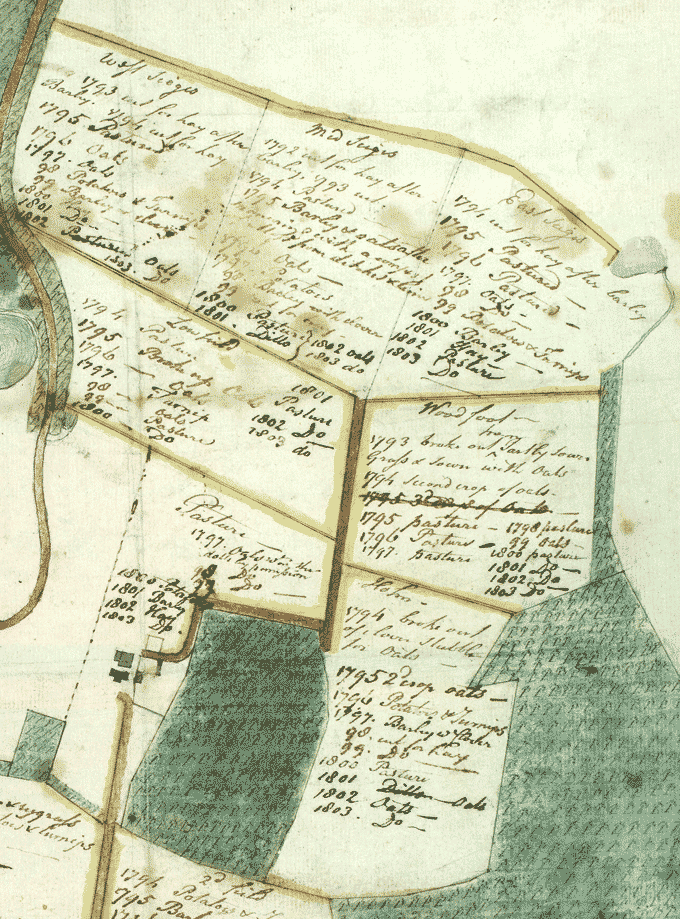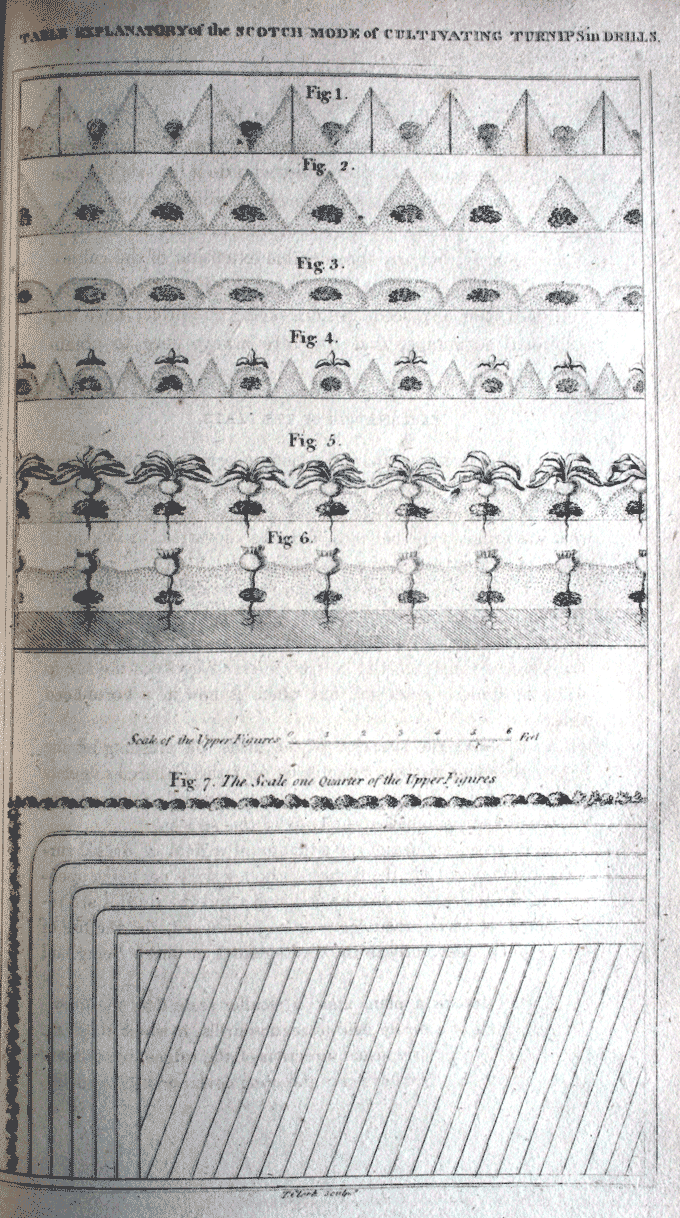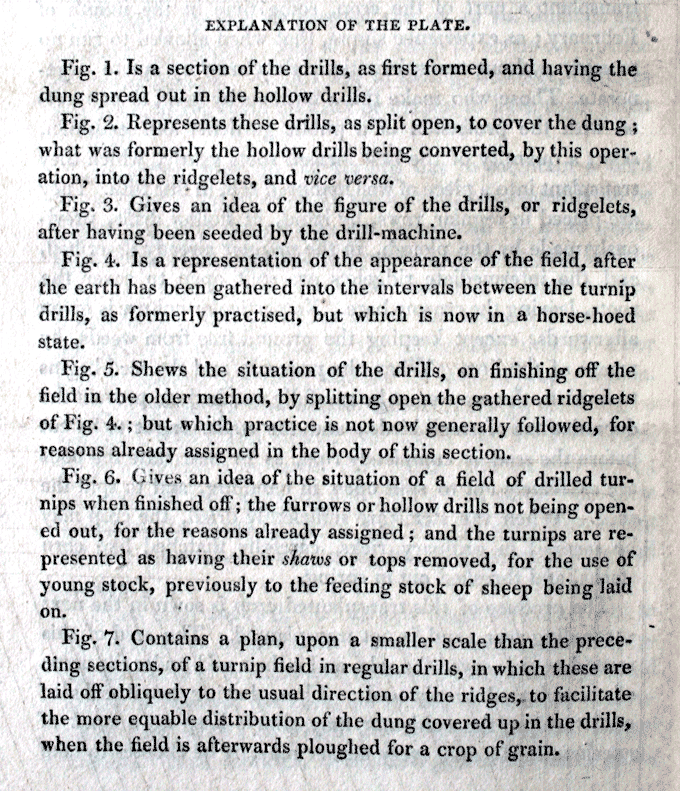The Enormous Benefit of Turnips
From the late 17th century landowners and farmers in Scotland started to improve their land. Small-holdings were amalgamated into larger single-tenant farms with longer leases, which provided tenants with sufficient time to invest in new methods of farming and crops. Many new leases actually specified that land improvements such as tree planting, enclosure and crop rotation were employed.
Crop rotation was introduced from England and resulted in yields doubling and even trebling. Turnips had been used in Scotland for domestic consumption for some time, but they were now introduced as a field crop to provide winter feed for livestock.
There are three sources in this resource:
Crop rotation at Murraythwaite, 1794
Turnip growing, 1814
A recipe for curing a cough, October 1749
|
Source 1: Crop rotation at Murraythwaite, 1794
This plan illustrates the rotation of crops implemented at Murraythwaite in Dumfriesshire. Moriquhat or Murraywhat, in the parish of Cummertrees in Dumfriesshire, was re-named Murraythwaite by a crown charter of 1766. In the fifteenth century the land belonged to the family of Ednam. Then, in 1466, Elizabeth Ednam married John Murray and granted the lands of Ednam to her son, Patrick. Thereafter the lands were held by members of the Murray family. At the time that this plan was drawn up, John Murray, known as the 'Auld Laird', was the owner of Murraythwaite. John Murray was born in 1726 and died, unmarried, in 1823.
The plan shows the boundaries for each field and lists the crops planted annually from 1792 to 1803. On the Woodfoot field, two crops of oats were followed by a crop of turnips or potatoes. These were followed by a crop of barley with clover, two crops of hay and then pasture.
View the full plan of Murraythwaite in a new window.

(National Records of Scotland reference: RHP6070) |
Transcription
West Siegis
1793 cut for hay after Barley
1794 cut for hay
1795 Pastured
1796 Oats
1797 Oats
1798 Potatoes & Turnips
1799 Barley & clover
1800 Hay
1801 D[itt]o [Hay]
1802 Oats
1803 D[itt]o [Oats]
Mid Seigis
1792 cut for hay after barley
1793 cut
1794 Pastured
1795 Barley & oats after manuring with a com[] of Moss from ditches & lime
1796 Oats
1797 Potatoes
1798 Barley with clover
1799 cut for hay
1800 Pastured
1801 D[itt]o [Pastured]
1802 Oats
1803 d[itt]o [oats]
East Seigis
1794 cut for hay after barley
1795 Pastured
1796 Pastured
1797 Oats
1798 D[itt]o [oats]
1799 Potatoes & Turnips
1800 barley
1801 Hay
1802 Pasture
1803 D[itt]o [Pasture]
Low field
1794 Pasture
1795 Broke up oats
1796 Oats
1797 Turnip
1798 Oats
1799 Pasture
1800 D[itt]o [Pasture]
1801 Pasture
1802 D[itt]o [Pasture]
1803 D[itt]o [Pasture]
Woodfoot
1793 broke out from partly sown Grass and sown with Oats
1794 second crop of oats
1795 pasture
1796 Pasture
1797 pasture
1798 pasture
1799 Oats
1800 pasture
1801 D[itt]o [pasture]
1802 D[itt]o [pasture]
1803 D[itt]o [pasture]
Pasture
1797 oats with the Rolls by permission
1798 D[itt]o [oats]
1799 D[itt]o [oats]
1800 Potatoes
1801 Barley
1802 Hay
1803 D[itt]o [hay]
Holm
1794 broke out of clover stubble for oats
1795 2nd crop of oats
1796 Potatoes & Turnips
1797 Barley w[i]t[h] Clover
1798 cut for hay
1799 D[itt]o [hay]
1800 Pasture
1801 Oats
1802 Oats
1803 D[itt]o [oats]
(National Records of Scotland reference: RHP6070) |
Source 2: Turnip growing, 1814
This illustration is taken from The General Report of the Agricultural State and Political Circumstances of Scotland edited by John Sinclair (1814). It demonstrates how turnips were to be grown in neat rows to benefit both the crop and the soil. Sir John Sinclair believed that growing turnips in large quantities would enable farmers to feed their livestock throughout the winter months. This in turn would allow them to build up their cattle and dairy herds, and extend the supply of fresh meat throughout the year.
Print a copy of the image and transcript below (new window, 2.4 MB, rich text format)

|

Transcript
Explanation of the Plate
Fig.1. Is a section of the drills, as first formed, and having the dung spread out in the hollow drills.
Fig.2. Represents these drills, as split open, to cover the dung; what was formerly the hollow drills being converted, by this operation, into the ridgelets, and vice versa.
Fig.3. Gives an idea of the figure of the drills, or ridgelets, after having been seeded by the drill-machine.
Fig.4. Is a representation of the appearance of the field, after the earth has been gathered into the intervals between the turnip drills, as formerly practised, but which is now in a horse-hoed state.
Fig.5. Shews the situation of the drills, on finishing off the field in the older method, by splitting open the gathered ridgelets of Fig.4.; but which practice is not now generally followed, for reasons already assigned in the body of this section.
Fig.6. Gives an idea of the situation of a field of drilled turnips when finished off; the furrows or hollow drills not being opened out, for the reasons already assigned; and the turnips are represented as having their shaws or tops removed, for the use of young stock, previously to the feeding stock of sheep being laid on.
Fig.7. Contains a plan, upon a smaller scale than the preceding sections, of a turnip field in regular drills, in which these are laid off obliquely to the usual direction of the ridges, to facilitate the more equable distribution of the dung covered up in the drills, when the field is afterwards ploughed for a crop of grain.
(From The General Report of the Agricultural State and Political Circumstances of Scotland edited by John Sinclair (1814)) |
Transcript
Nans for Allis Cough you get some turneeps slice
them in very thin Sclices beat some brown sugar candie
lay some of itt in the bottom of a trencher and
then lay on some of the scliced turneeps then lay
another layer of sugar candy and so on till your
trencher is heaped then lay another trencher above
them and lay a stone above all to press itt when all
the sugar is well melted pour off the juice and give him
a spoonful frequently
(National Records of Scotland reference: GD113/5/421)
Glossary
nans, nanes or nanis = for the purpose of
trencher = a serving plate
sclices, scliced = sliced
[Back to top] |



![Image shows a receipt [recipe] for curing a cough, as recorded by Lady Elphinstone in 1749. National Records of Scotland reference GD113/5/421](Images/680Images/GD113-5-421-b-680p.gif)